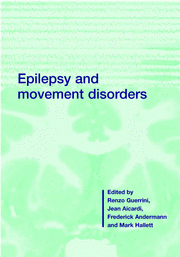Book contents
- Frontmatter
- Contents
- List of contributors
- Preface and overview
- 1 Epilepsies as channelopathies
- 2 Epilepsy and movement disorders in the GABAA receptor β3 subunit knockout mouse: model of Angelman syndrome
- 3 Genetic reflex epilepsy from chicken to man: relations between genetic reflex epilepsy and movement disorders
- 4 Functional MRI of the motor cortex
- 5 Neuromagnetic methods and transcranial magnetic stimulation for testing sensorimotor cortex excitability
- 6 Motor dysfunction resulting from epileptic activity involving the sensorimotor cortex
- 7 Nocturnal frontal lobe epilepsy
- 8 Motor cortex hyperexcitability in dystonia
- 9 The paroxysmal dyskinesias
- 10 Normal startle and startle-induced epileptic seizures
- 11 Hyperekplexia: genetics and culture-bound stimulus-induced disorders
- 12 Myoclonus and epilepsy
- 13 The spectrum of epilepsy and movement disorders in EPC
- 14 Seizures, myoclonus and cerebellar dysfunction in progressive myoclonus epilepsies
- 15 Opercular epilepsies with oromotor dysfunction
- 16 Facial seizures associated with brainstem and cerebellar lesions
- 17 Neonatal movement disorders: epileptic or non-epileptic
- 18 Epileptic and non-epileptic periodic motor phenomena in children with encephalopathy
- 19 Epileptic stereotypies in children
- 20 Non-epileptic paroxysmal eye movements
- 21 Shuddering and benign myoclonus of early infancy
- 22 Epilepsy and cerebral palsy
- 23 Sydenham chorea
- 24 Alternating hemiplegia of childhood
- 25 Motor attacks in Sturge–Weber syndrome
- 26 Syndromes with epilepsy and paroxysmal dyskinesia
- 27 Epilepsy genes: the search grows longer
- 28 Genetics of the overlap between epilepsy and movement disorders
- 29 Seizures and movement disorders precipitated by drugs
- 30 Steroid responsive motor disorders associated with epilepsy
- 31 Drugs for epilepsy and movement disorders
- Index
- Plate section
6 - Motor dysfunction resulting from epileptic activity involving the sensorimotor cortex
Published online by Cambridge University Press: 03 May 2010
- Frontmatter
- Contents
- List of contributors
- Preface and overview
- 1 Epilepsies as channelopathies
- 2 Epilepsy and movement disorders in the GABAA receptor β3 subunit knockout mouse: model of Angelman syndrome
- 3 Genetic reflex epilepsy from chicken to man: relations between genetic reflex epilepsy and movement disorders
- 4 Functional MRI of the motor cortex
- 5 Neuromagnetic methods and transcranial magnetic stimulation for testing sensorimotor cortex excitability
- 6 Motor dysfunction resulting from epileptic activity involving the sensorimotor cortex
- 7 Nocturnal frontal lobe epilepsy
- 8 Motor cortex hyperexcitability in dystonia
- 9 The paroxysmal dyskinesias
- 10 Normal startle and startle-induced epileptic seizures
- 11 Hyperekplexia: genetics and culture-bound stimulus-induced disorders
- 12 Myoclonus and epilepsy
- 13 The spectrum of epilepsy and movement disorders in EPC
- 14 Seizures, myoclonus and cerebellar dysfunction in progressive myoclonus epilepsies
- 15 Opercular epilepsies with oromotor dysfunction
- 16 Facial seizures associated with brainstem and cerebellar lesions
- 17 Neonatal movement disorders: epileptic or non-epileptic
- 18 Epileptic and non-epileptic periodic motor phenomena in children with encephalopathy
- 19 Epileptic stereotypies in children
- 20 Non-epileptic paroxysmal eye movements
- 21 Shuddering and benign myoclonus of early infancy
- 22 Epilepsy and cerebral palsy
- 23 Sydenham chorea
- 24 Alternating hemiplegia of childhood
- 25 Motor attacks in Sturge–Weber syndrome
- 26 Syndromes with epilepsy and paroxysmal dyskinesia
- 27 Epilepsy genes: the search grows longer
- 28 Genetics of the overlap between epilepsy and movement disorders
- 29 Seizures and movement disorders precipitated by drugs
- 30 Steroid responsive motor disorders associated with epilepsy
- 31 Drugs for epilepsy and movement disorders
- Index
- Plate section
Summary
Introduction
Epileptic activity involving the sensorimotor cortex can be associated with a wide spectrum of motor manifestations, such as clonic or tonic phenomena, paresis (Penfield & Jasper, 1954; Fisher, 1978; Globus et al., 1982; Tinuper et al., 1987; Lee & Lerner, 1990; Primavera et al., 1993; So, 1995), epileptic negative myoclonus (Tassinari, 1981; Guerrini et al., 1993; Tassinari et al., 1995; Noachtar et al., 1997), apraxia (Neville & Boyd, 1995; Maquet et al., 1995), ataxia (Bennett et al., 1982; Dalla Bernardina et al., 1989), and motor neglect (Galletti et al., 1992; Guerrini et al., 1993). Neurophysiological investigations and, more recently, functional imaging studies have provided a growing amount of data that have proved extremely useful for diagnostic purposes and for pathophysiological speculations. However, the understanding of the mechanisms underlying the different clinical events associated with paroxysmal activity in the sensorimotor cortex is still incomplete. Excitatory or disinhibitory neuronal mechanisms as well as hypersynchronous inhibitory phenomena may play a role (Engel, 1995), as suggested by the finding that ‘interictal’ spike-and-wave discharges (SW) involving a specific cortical area can disrupt its physiological functions (Shewmon & Erwin, 1988a, b, c; 1989).
In the present chapter, we will focus on those types of motor dysfunction resulting from epileptic activity in the sensorimotor cortex, characterized clinically by an altered execution of a motor task or by the inability to perform it, such as epileptic negative myoclonus (ENM), partial atonic seizures (PAS), and syndromes resulting from frequent paroxysmal activity in the sensorimotor cortex.
- Type
- Chapter
- Information
- Epilepsy and Movement Disorders , pp. 77 - 96Publisher: Cambridge University PressPrint publication year: 2001
- 1
- Cited by



